(part 2 of a 2-part series)
After achieving independence from the United States ten months after the end of WWII, the military of the Philippines was infused with a variety of WWII American weapons, some of which are still in use in 2018.

(Recruits train with a mix of M16s and M1 Garands in 2018.)

(Philippines army soldiers display weapons captured from Abu Sayyaf in 2017 including a pair of M1 Garands, one of which has been spray-painted glossy black.)
during WWII and the end of the war
The Philippines, at the time an American Commonwealth, was overrun by Japanese forces in late 1941 – early 1942. Throughout the occupation, guerillas put up a strong resistance to the IJA’s 14th Area Army. Some of the guerillas would later be integrated into the post-WWII Philippines military.
Prior to WWII, the United States had set a timetable for the Philippines to become independent in mid-1945. During WWII it was repeatedly stated that this would be honored and indeed, the Philippines became an independent country on 4 July 1946, only several months behind the 1930s plan and less than a year after WWII ended.

(Ex-US Army M5 Stuart light tanks of the Armed Forces of the Philippines (AFP) after independence. Already obsolete in the tank vs tank role, these served into the 1950s.)
In some ways, the non-delay of independence was a mixed blessing. Certainly it satisfied the wishes of the people who had been ruled by Spain, then the USA, then Japan. However the country was absolutely devastated by WWII. In the Pacific theatre, nowhere other than Japan itself suffered such severe infrastructure damage. Inbewteen the time major fighting on Luzon ended in July 1945 and independence was only one year; inbetween the overall end of WWII and independence was only 44 weeks.

(An ex-US Navy PBY Catalina used by the Philippines after independence.)
To effect an orderly transition, units were created prior to independence and at 00:00 on 30 June 1946, American control of Philippines units ended. The country became independent on 4 July 1946.
The initial Philippines army was just 25,000 troops in 1946, plus about another 10,000 in the Philippines Constabulary and several thousand more in the navy and air force.
National defense was not considered a pressing priority during the countdown to independence, nor immediately thereafter, and the early Filipino military was entirely ex-American gear of WWII.
ex-Japanese equipment remaining on Philippines territory
The defeated IJA’s 14th Area Army left substantial numbers of firearms and other gear in 1945. None of this was incorporated into the independent Philippines military in 1946.
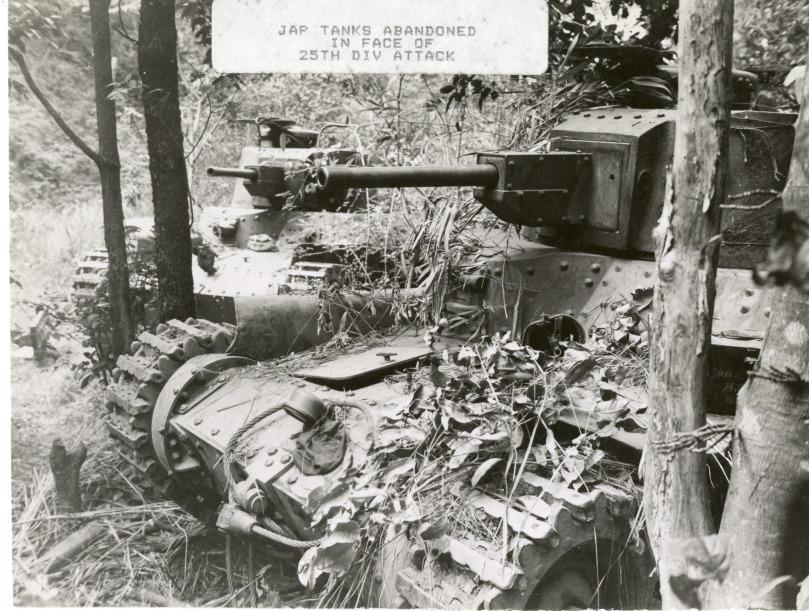
(A pair of Type 97 Shinhoto Chi-Ha tanks captured intact in the Philippines near the end of WWII.)
Less anything of intelligence value, American military policy in the Pacific theatre was to destroy captured Japanese equipment. This policy was adhered to during the 1944 – 1945 liberation and through the immediate postwar period in late 1945.

(A US Navy officer supervises the destruction of a pile of Arisakas in the Philippines near the end of WWII.)
There was initially grumbling in the Philippines over this, as with only months to go before independence, it was viewed as depriving the new military of a source for free equipment. In retrospect, it probably wouldn’t have mattered as none of the Japanese gear shared ammunition or spare parts commonality with American weapons which would form the core of the Philippines military for decades.

(This ex-Japanese Type 94 75mm gun was used as a training aid and is today preserved at the Philippines Military Academy. The Philippines army removed the gunshield and replaced the WWII wheels with American rims and tires.) (photo by Lakwatserong Tatay)

(Demilitarized Japanese weaponry was common in the Philippines after WWII, like these Type 10 anti-aircraft guns used as lawn decoration by the Manila Hotel in the 1950s. This hotel, which is still in business in 2018, has hosted guests including Ernest Hemingway, Gen. Dwight Eisenhower, Gen. Masaharu Homma, Gen. Douglas MacArthur, and Imelda Marcos over the years. The guns were removed in 1975.)
the case of “freed” American weapons
When Japan overran the Philippines, a significant number of American weapons were captured intact. The Japanese captured 27,412 rifles (mostly M1903 Springfields but also some M1917s and a few M1 Garands) along with 68 BARs, 218 machine guns, and 1,161 handguns.

(A Japanese general inspects a Filipino soldier of the puppet army project using a M1903 Springfield during the occupation.)
Some of these captured weapons were dispersed to Japanese forces in the East Indies and South Pacific, but by 1943 sea transport had become dangerous and most were retained in reserve in the occupied Philippines. When the empire declared the ‘Second Philippine Republic’, a short-lived puppet regime, it’s mediocre attempt at a collaborator army was armed with ex-American weapons.
When American forces returned in 1944 and 1945, surprising quantities of these guns from 1941 were recaptured. It was decided to treat them as Japanese weapons and they were destroyed.

(A pile of “freed” American weapons in the Philippines, mostly M1917 rifles, burned by the US Army at the end of WWII.)
WWII weapons in the Philippines after independence
tanks
The M4 Sherman was the Philippines first main battle tank. The first Shermans were all ex-US Army tanks remaining on the islands from WWII. A second batch came in 1950 and a small third batch equipped Filipino forces fighting the Korean War.

(Philippines army Shermans shortly after the country became independent.)

(M4A2 Shermans of the Philippines army. This variant had a 75mm gun and a General Motors 6064 diesel powerplant.)
The Sherman weighed 33 to 42 tons depending on the variant, and had a 5-man crew. Besides the main gun, of which the type varied, there were two machine guns (hull and coaxial) and often a provision for a turret-top machine gun.
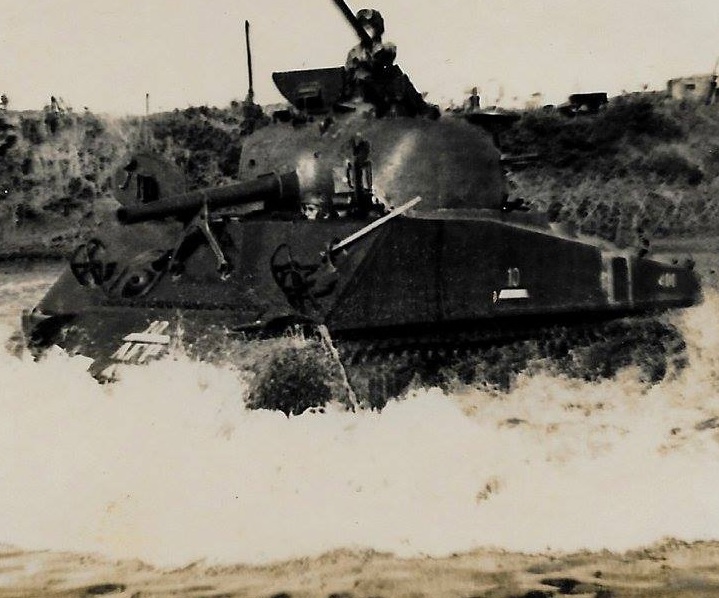
(M4A3 Sherman of the Philippines army fording a river. This version had a Ford GAA gasoline engine. The bow M1919 .30cal machine gun is missing from this tank; later in the Sherman’s Filipino career these were often deleted along with the bow gunner crew position.)
Tanks in the Philippines military have been a source of debate since it was founded. The country’s geography (an island group filled with mountains and jungle) makes many traditional armored tactics unrealistic, while tanks are expensive to man, maintain, and fuel. On the other side of the debate, it is pointed out (even today) that during WWII, both Japan and the USA made effective use of tanks in the country.
Small numbers of Patton-series tanks were obtained during the 1950s but no great urgency was put into replacing the WWII-veteran Shermans. Declining numbers remained in use into the 1960s.

(Officer cadets pose on a M4 Sherman in the 1960s. The unit insignia is the 1st (“Tabak”) Division, which was formed during the American era in 1936 and still exists in 2018.)

(In 1977, British-made FV101 Scorpions were bought to replace remaining WWII armored fighting vehicles. Here, one disembarks from the WWII landing ship BRP Benguet, previously USS Daviess County (LST-692). During WWII this ship landed tanks in southern France in 1944. As of 2018 BRP Benguet is still active.)
Along with the Sherman tanks, some M7 Priest self-propelled howitzers were operated. These had the hull of a Sherman tank but the turret replaced with an open-top position for a M2A1 artillery piece, which fired a 105mm shell out to 7 miles.
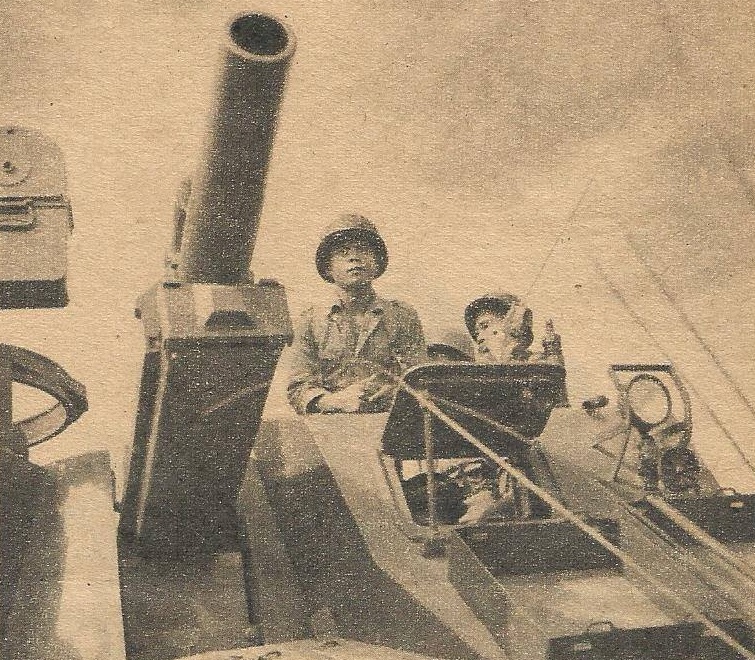
(Philippines army M7 Priest, probably in the early 1950s.)
The Priests were an effective system, if expensive to operate compared to towed artillery. They were retired around the same time as the M4 Shermans they supported.
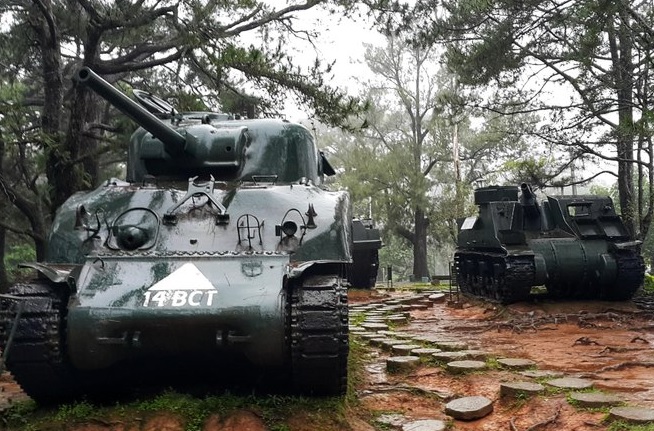
(At the Philippines Military Academy, a M7 Priest is preserved alongside a M4A1 Sherman.)
The Philippines also operated a small number of M18 Hellcat tank destroyers. This vehicle had a Continental R975 gasoline engine and weighed 17¾ tons. It was armed with a M1A1 76mm high-velocity gun with a range of 14,650 yards. Forty-five rounds were carried.

(Philippines army M18 Hellcat of the 10th Infantry Battalion during the 1950s.)
other armored vehicles
The 6×6 M8 Greyhound armored car was more well-known for it’s use in Europe during WWII, but it also saw use against the Japanese in the Philippines. Although it was armed with a M6 37mm gun, it’s armor was only ¾” to 1″ thick and it was not intended to face enemy tanks. It was however fast (55mph on paved roads), agile, and above all very cheap to operate.

(Philippines M8 Greyhounds)
The Philippines operated some ex-US Army examples, finding their cross-country ability to be sufficient vs their operating costs, and also appreciating the fact that they put less wear on paved roads than tracked vehicles. These remained in declining use into the 1970s. Later in their career, when they were tasked with fighting NPA and Moro rebels, some had their rear armor skirts removed to make them lighter.
The Philippines used M3 half-tracks for a variety of roles. This 9-ton vehicle was 20’3″ long and powered by a White 160AX gasoline engine. It combined the best aspects of a wheeled truck and a tracked vehicle; with a top road speed of 45mph and excellent off-road ability. In the passenger configuration, it could move 10 soldiers plus the vehicle crew. It was lightly armored (¼” to ½”) and open-topped.

During the 1940s – 1950s fighting against the Huks, both the Philippines military and the Philippines Constabulary (a paramilitary police force) used half-tracks. It was also used in combat by the Filipino contingent during the Korean War.

(The Constabulary was formed during the American era and was operational from 1901 – 1942, and then from 1944 – 1991. Shown here in the late 1940s or early 1950s, a patrol is mounted on M3 half-tracks armed with M2 Browning .50cal and M1919 .30cal machine guns.)
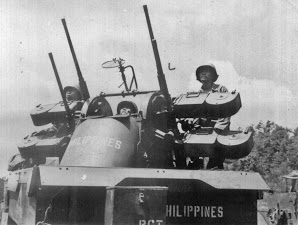
(M45 quad .50cal AA gun mounted on a Philippines army M3 during the Korean War.)
The half-tracks remained in use until the end of the 1960s when they were replaced by M113s.
The M3 White scout car was used for a number of missions by the US Army during WWII. Manufactured by White Motor Company, it weighed 4 tons and could carry 7 passengers. It was powered by a Hercules JXD gasoline engine and usually was armed with a machine gun.

(M3 Whites used as reviewing vehicles for generals of the Philippines air force.)

(An up-armored M3 White used by the Philippines National Police during the 1990s in Sulu province.)
One of the less famous American vehicles of WWII, the M3 White was tremendously popular in the Philippines. It was still in regular frontline use as late as 1977, and in niche roles into the 1990s.
other vehicles
The Willys jeep was used in significant numbers by the Philippines army after independence, and other governmental agencies used them as well. These were almost invariably ex-US Army / ex-US Marine Corps jeeps that had taken part in WWII and then were either sold at minimal cost or transferred for free in lieu of transporting them back to the USA.

(Filipino soldiers ride a WWII Willys jeep during the Korean War.)
Along with some directly taken into civilian use after WWII, some ex-Philippines army Willys jeeps were later auctioned off as surplus. Some were converted into micro-busses called “jeepneys”. The same nickname was later given to likewise converted M151 MUTTs of the Cold War era and today, is general slang for any such vehicle in the Philippines.
The Dodge WC-57 command car was produced by Chrysler for a short run that lasted from 1942 – 1944. This ¾ ton vehicle was used for a number of minor roles.

(WC-57 at Clark airbase in the mid-1940s.) (photo via wc57.com website)
After WWII there were more than the American military needed and some were transferred to the Philippines.
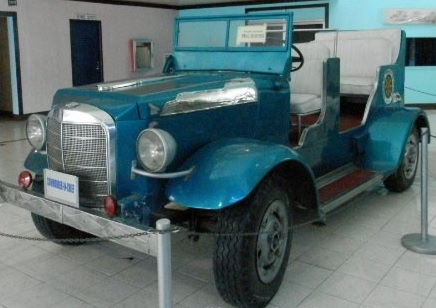
(This modified WC-57 served as the Philippines first presidential car.)
The WC-53 Carryall was a basic WWII vehicle based largely on chassis and body components of a civilian 1939 Dodge car. It could carry six passengers or a ½ ton of cargo. During the war, these vehicles were produced more for expediency than anything else, and were considered secondary assets by the US military after the end of WWII. Some were transferred to the new Philippines military.

These vehicles remained in Philippines army use into the 1950s.
artillery
The M2A1 was the standard American light howitzer during WWII. The M2A1’s basic M1 105mm HE shell weighed 15 lbs and had a range of 7 miles. Anti-tank (M67) and smoke (M84) shells were also available. The M2A1, which was later redesignated M101, weighed 2½ tons.

(Refurbished M101 of the Philippines army in 2010.)
A total of 150 of these howitzers were delivered to the Philippines army. They did not come at the time of independence in 1946, but rather in 1957. Of these, 118 are still in service in 2018; all having been refurbished over the years, some several times. There are also 12 guns which underwent a complete modernization in 1997 by the French company GIAT, resulting in a nearly half-new weapon.
firearms
In 1946, the Philippines army was simply a snapshot of the guns American GIs had carried during WWII: The M2 Browning, M1918 BAR, M1919, M1 Garand, M1903 Springfield, M3 Grease Gun, M1 carbine, and M1911.
the M1911
This .45 semi-auto was in service in 1946 and has never left the Philippines military since. The M1911 is 8¼” long and fires the 45ACP cartridge (830fps muzzle velocity) from a 7-round detachable magazine.

(Philippines army soldiers drill with M1911s in 2005.)
Actual WWII-used M1911s are mostly retired by now, replaced over the decades by replenishment orders from the USA and locally-produced M1911 variants.
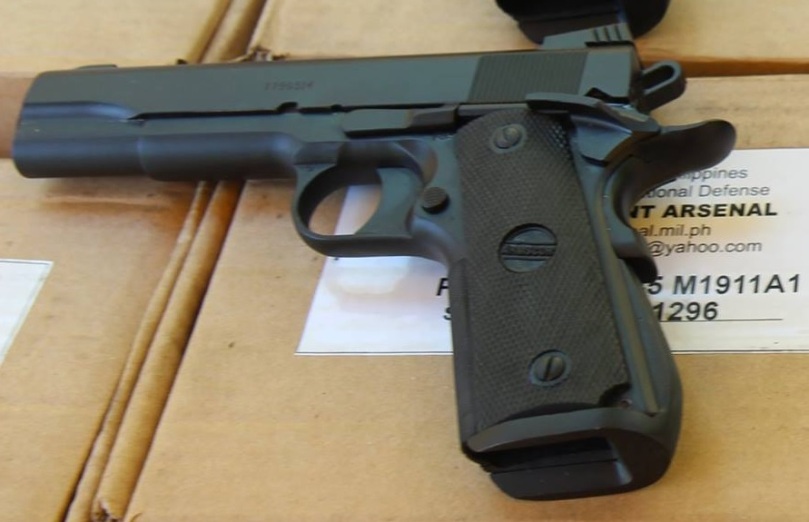
(An old M1911A1 completely rebuilt by Philippines Government Arsenal in 2017.)
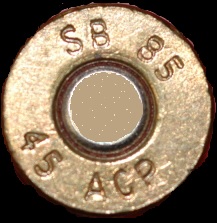
(Squires Bingham headstamped 45ACP)
Squires Bingham Co. was a company in Marikina (today a neighborhood of Manila) making farm tools, recreational .22 rimfire ammo, and motorcycle parts during the American era. After WWII they branched into military-oriented goods and became a leading supplier of 45ACP. Squires Bingham later formed the nucleus of the Armscor corporation. Today the Philippines is easily self-sufficient in 45ACP, both for military and civilian use, and is a net exporter of the caliber.
the M3 Grease Gun
During WWII, the United States built 622,163 of these submachine guns as a cheap alternative to the Thompson. None the less it was a very effective weapon, being compact (just 22″ with the stock collapsed), reliable, and easy to use. The Grease Gun (it’s unofficial nickname, in reference to 1940s mechanic’s tools) weighed 8 lbs and fired the 45ACP cartridge (920fps muzzle velocity) at 450rpm from a 30-round detachable magazine. In theory it was accurate to 100 yards but practically it was a close-quarters weapon.

As it turned out, M3s enjoyed long post-WWII use but in 1946, this was unforeseen and they were considered limited-value guns and made eligible for transfer to American allies, including the Philippines.
In the Philippines military, the M3 was greatly liked due to it’s light weight, ease of maintenance, and ammunition commonality with the M1911. As the introduction of selective fire rifles made submachine guns redundant later in the Cold War, the Grease Gun lingered on in the maritime branches (Philippines navy and marines) where it’s small size and high rate of fire made it ideal for amphibious assaults and boarding actions.
In May 2004, a quite remarkable rebuild of these WWII guns was unveiled. Called the “Generation II” or more officially PN/PMC-M3, a prototype was hand-assembled at Fort Bonifacio (formerly the US Army’s Ft. McKinley of WWII). Series conversions started soon after.

(In this 2013 photo, the sailor in dungarees has a basic WWII M3 Grease Gun (with a new locally-made muzzle brake) while the marine has a Generation II rebuild.)
The Generation II retains the WWII action, collapsible wire stock, and (refurbished) magazine. Changes are an integral Philippines-made suppressor, Simmons red-dot scope replacing the iron sights, nylon sling, and a digicam finish.

(photo via armoryblog.com website)
The Generation II conversions cost less than a quarter of buying new modern auto-carbines and are very popular in the Philippines marine corps. Even though portions of the firing components are now 70 years old, the rebuilt M3s remain very reliable. In 2010 a night-vision optics package was made available for these guns. There are no plans to retire them anytime soon.
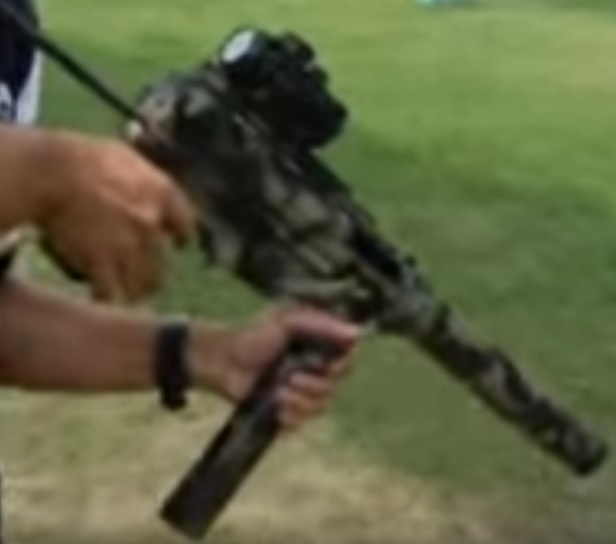
the M1 carbine
A mainstay of the US Army during WWII, the M1 carbine was intended for troops not needing a M1 Garand, but still requiring something more substantial than a pistol. This semi-automatic weapon was 3′ long and weighed 5¼ lbs. It fired the .30 Carbine cartridge (1,990fps muzzle velocity) from a 15 round box magazine.

While WWII was still in progress, the M1 carbine was one of the weapons the Allies supplied Filipino guerillas with. As American forced returned in 1944 and 1945, guerilla units made contact with advancing American troops and were re-equipped and reorganized as regular fighting units.
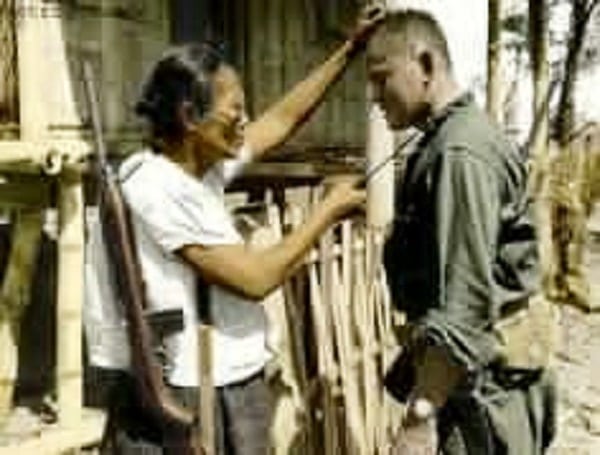
(Nieves Fernandez was a schoolteacher before WWII. During the occupation, she was credited with killing 200 Japanese troops and was shot once. Eventually she led a guerilla group and was considered an equivalent rank to captain by the US Army. Here she illustrates her wares to an American GI, a M1 carbine and a bolo knife. Fernandez passed away in 1996.)

(An American instructor, with M1 carbine, stands with Filipino guerillas after they were refitted upon making contact with the US Army in 1945. They were armed with M1 carbines and M1A1 tommyguns.)
After the Philippines became independent, many of the guerilla groups were partially rolled into the new army as part of their disbandment procedure; bringing with them their M1 carbines along with those of their demobilized comrades.

(In the late 1960s the already-mentioned Squires Bingham company bought an entire .30 Carbine ammo production line – jigs, presses, molds, and even some incomplete brass – from the Italian company Leon Beaux which had filled the Italian army’s M1 carbines after WWII. This turned out to be an immensely profitable move, satisfying both the Philippines army’s needs and an export market. Later, the machinery was found suitable to make 5.56 NATO. The metro Manila government annexed the former suburb of Marikina largely to put the Armscor juggernaut into it’s taxation area.)
Besides the transfers during and immediately after WWII, a second batch of M1 carbines was donated by the USA in 1950, and during the early 1960s an additional 8,831 were transferred under the Military Assistance Program (MAP). As time passed, the M1 Carbines passed from the regular Philippines military to second-line, reserve, and police use. Unfortunately a lot of them also ended up in the hands of the various rebel groups over the years (the Huks, the NPA, the Moros, and Abu Sayyaf) and regular criminal enterprises.

(The gun at the bottom is either a M2 – the selective fire variant of the M1 introduced in 1945 – or a M1 rebuilt with a Type V “potbelly” stock; in either case it has been modified with a homemade pistol grip and a South Korean-made suppressor which is popular in the Philippines. The two weapons above it are M79 grenade launchers of the Vietnam War era. These guns were captured from rebels in March 2018.)

(Members of a Reformed Ilaga vigilante group in 2008, armed with a Cold War M14 rifle and WWII M1 carbine.) (photo by Mark Navales)
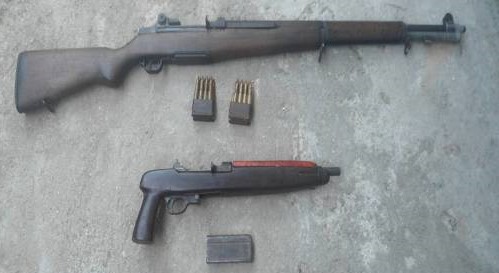
(WWII guns seized by authorities in Negros province in 2015; a M1 Garand rifle and a M1 carbine which has been crafted into a pistol.)
the M1919
The air-cooled M1919 was the main American medium machine gun type of WWII. It fired the .30-06 Springfield cartridge from a 250-round belt at 500rpm. It weighed 38 lbs and had iron sights.
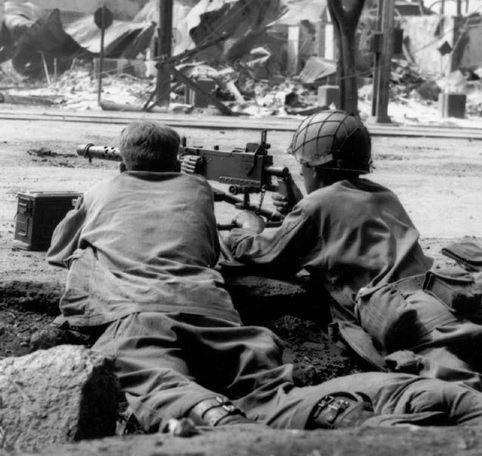
(American M1919A4 in action inside Manila in February 1945.)
The M1919 was an original piece of Philippines army equipment at the time of independence and has never left service. For many years a bonus was that it shared ammunition with the M1 Garand rifle; in any case various proposals to phase it out have fell short of funding.
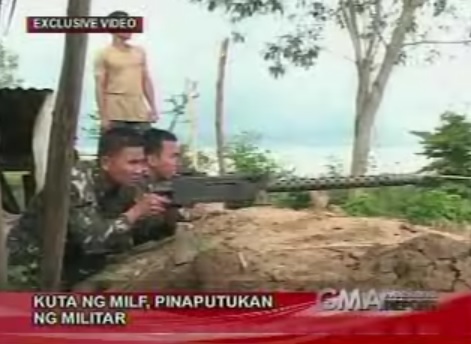
(Philippines army M1919 in action against Moro rebels in August 2008.) (image via TV-7 Manila)

(These guns were captured from defeated ISIS forces during the five-month battle of Marawi in 2017. Two WWII guns are present; a M1918 BAR in the center and a M1919A4 second from the right. These guns were destroyed after the battle.) (photo via News5)
the M1918 Browning Automatic Rifle
Like the M1919 machine gun, the BAR was an original piece of Philippines army gear in 1946. The M1918 BAR was 3’11” long and weighed 16 lbs. It fired the .30-06 Springfield cartridge at 500rpm from a 20-round detachable box magazine.
During the 1940s – 1950s fighting against the Huks (whom also used BARs) the M1918 was an effective way of bringing automatic firepower to foot infantry units, with the .30-06 cartridge proving effective in dense vegetation. Much like the M1919, the M1918 BAR also had ammunition commonality with the M1 Garand.
For the Philippines army, the adoption of the selective fire M14 (and later, M16) made the automatic rifleman billet somewhat redundant, at the same time the SAW concept supplanted it in tactics. None the less, BARs remained in use with the military and Constabulary into the late 1970s. Rebel groups have also acquired them over the years and up to 2018, they are still occasionally seized.

(A BAR with a Reformed Ilaga vigilante group in 2008.) (photo via guns.com website)
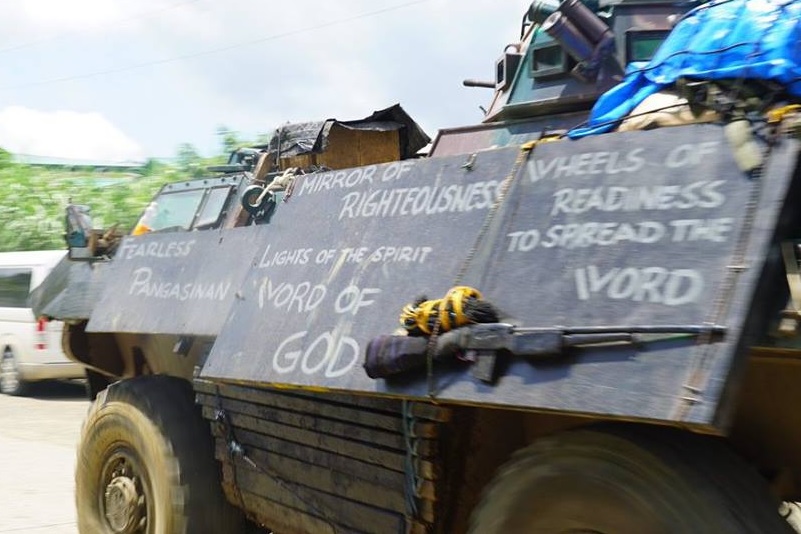
(A BAR tied to makeshift armor on a Philippines army vehicle during the Marawi battle in 2017. Judging by it’s condition and stowage method, it may have been a trophy rather than a crew-use asset.)
the M2 Browning .50cal
Although this heavy machine gun certainly saw use throughout all of WWII, it’s almost difficult to categorize the long-serving “Ma Deuce” as a WWII-era weapon as it is still in frontline use worldwide in 2018. The belt-fed M2, of which there were three main variants during WWII, weighs 84 lbs and fires the 50BMG cartridge (2,910fps muzzle velocity) at 600rpm.
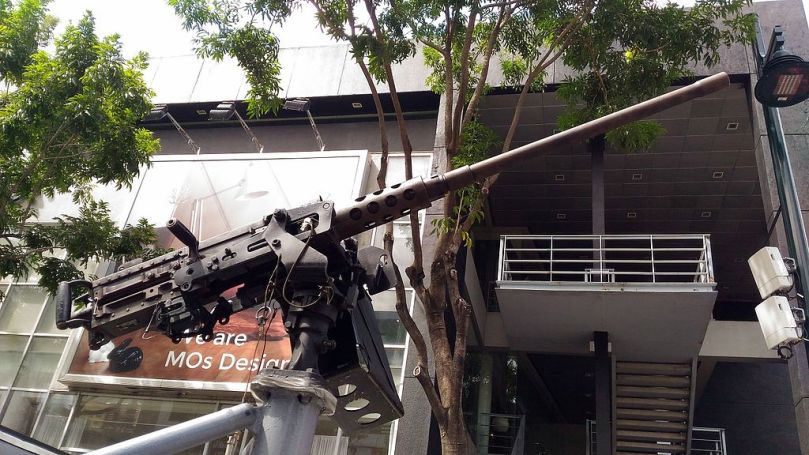
(The M2HB was and remains the basic version. This one was photographed during a Philippines military expo in 2016.)
The Philippines military used the M2 in combat against all of the insurgencies from the Huks onwards, and uses it in infantry, vehicular, and shipboard roles. It was also used in ground fighting and AA work during the Korean War.
Various rebel groups have also gotten their hands on M2s over the years, either from recovery off WWII battlefields or pilferage from the government and capture from Philippine military units.

(This gun captured from ISIS in the Philippines during 2018 is interesting; it is not the common M2HB variant but rather a AN/M2 aircraft version from WWII, with the front sight missing, and a flash hider added along with spade grips from either a M2HB or M1919. It may very well have come off a downed WWII warplane in the jungle.) (photo via Washington Times newspaper)
Under President Rodrigo Duterte, the Philippines military is making a concerted effort to eliminate .50cal weaponry from rebel groups in the country. Started in late 2017, this multi-pronged approach involves premium pricing for M2s in buy-back programs, better security of M2s and 50BMG ammunition at military bases, and efforts by the Philippines navy and customs to choke off black market importation. By November 2018, the “ammo starvation” project appears to be bearing fruit. Increasingly in 2018, rebel groups were abandoning the use of M2s in favor of locally-made bolt action .50cal guns, presumably to preserve remaining 50BMG stockpiles.

(Guns captured from Philippine rebels in 2018; Cold War-era M14s, M1 Garands from WWII, a modern M16, and a locally-made single-shot .50cal gun using the chassis of a civilian pistol.)
the M1903 Springfield
Although relegated to secondary status behind the M1 Garand during WWII, the M1903 Springfield was the main rifle of both the American-era Philippine Scouts and the US Army garrison resisting the Japanese in 1941. By a huge margin it was the main weapon employed by guerillas during the occupation, and after WWII, had a quiet but surprisingly long career in the post-independence era.

(Both the M1903 rifle and it’s bayonets had a long history in the Philippines even before WWII. Shown atop is the M1903’s normal M1905 bayonet, and below it the M1915 model which resembled a traditional Filipino bolo knife and was used only in the Commonwealth.) (photo from Forgotten Weapons website)
The M1903 was a bolt-action rifle weighing 8¾ lbs firing the .30-06 Springfield cartridge from a stripper-loaded 5-round internal magazine. It was a well-built, reliable, and accurate rifle; albeit made obsolete by the adoption of semi-auto rifles.

In 1946 several thousand M1903s were gifted to the new Philippines military, which began forming in the months prior to independence. Smaller numbers were transferred to the Constabulary and police. Another lot came in 1950 from an emergency aid package to combat the Huk insurrection, and tiny piecemeal lots probably came as American bases were relinquished to Philippines control during the Cold War.
The Springfield was well-liked despite it’s obsolescence, as it shared ammo with the M1 Garand, M1918 BAR, and M1919 machine gun. Quite remarkably some Philippines soldiers in the Korean War carried M1903s, and the gun remained in declining use as late as the 1960s.
the M1 Garand
Outside of the United States itself, no country’s military had such a long and deep involvement with the M1 Garand as the Philippines.

(Philippines army soldier firing a M1 Garand during the Korean War.)

(The Philippines Merchant Marine Academy teaches in a military school format. Here students march with M1 Garands.)
The M1 Garand weighs 9½ lbs and fires the .30-06 Springfield cartridge (2,800fps muzzle velocity) from a 8-round internal en bloc magazine.

(A recruit training with a M1 Garand in January 2018.)
As to the number of M1 Garands the Philippines received over the years, the answer is; nobody actually knows for sure.
The quantity given to guerillas after they linked up with American troops in 1944 – 1945 will probably never be known. Most of these rolled into the new army in 1946. Next, thousands of Garands were directly donated to the new Philippines military inbetween the end of WWII in 1945 and independence in 1946. Another 36,930 were received inbetween the time of independence in July 1946 and the end of the Huk insurgency emergency aid tranche in the mid-1950s. In 1963, another 11,597 Garands were transferred via MAP from US Army Pacific Command warehouses. Smaller lots came via informal transfers during the Vietnam War era, aboard transferred warships, and piecemeal as American bases in the Philippines were relinquished. Several thousand more were acquired in roundabout ways during the Marcos era, mostly by alleged unsanctioned diversion of American-aid M1s to the South Vietnamese army, or by third-party sales on the international market. By best guess, at least 112,000 M1 Garands were in Philippines use, an astonishing total that represents roughly 1 out of every 49 ever manufactured.
The M1 Garand was the country’s main battle rifle from independence in 1946 until M14s appeared in the 1960s, followed by M16s some years thereafter. As both the M14 and M16 entered service, the M1 Garand remained in use.
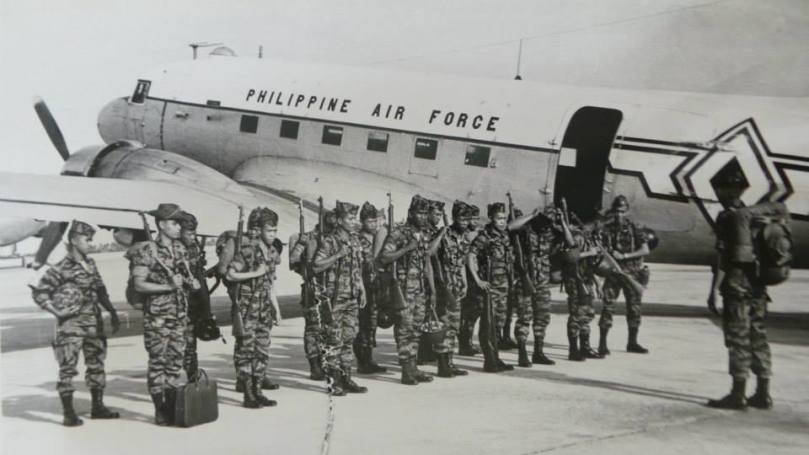
(Philippines soldiers with M1 Garands prepare to board a C-47 Skytrain, another WWII item, during the 1960s.)
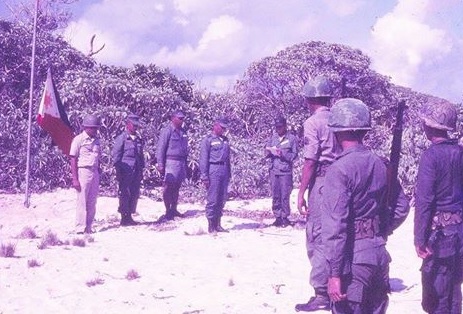
(Philippines marines with M1 Garands raise their flag on one of the disputed Spratley Islands in 1970. In 2018, ownership of the islands remains a point of friction between the Philippines and China.)
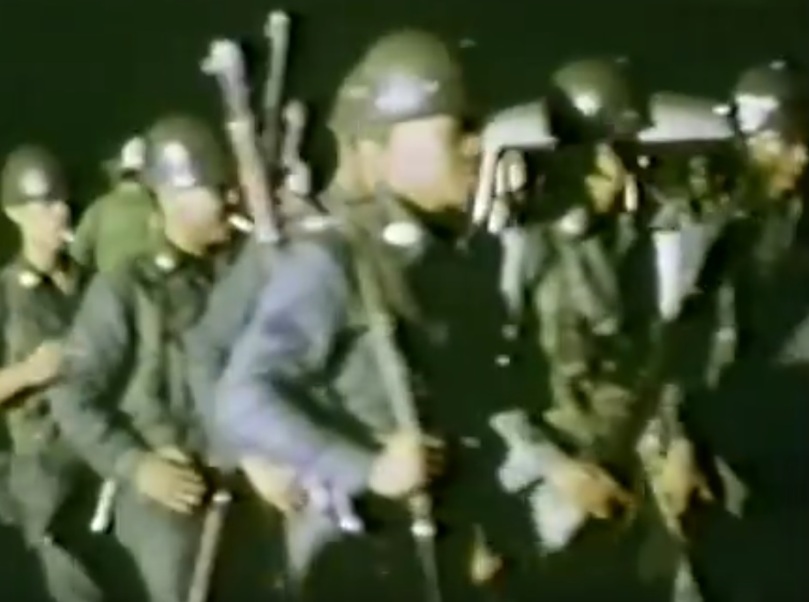
(Soldiers with Garands in Manila after President Ferdinand Marcos declared martial law in 1972.)

(A CAFGU patrol armed with M1 Garands in 2010.) (photo by Jay Directo)
In April 2017, the Philippines announced the repatriation of 86,000 M1 Garands as detailed later below. None the less at the end of 2018 there were still several thousand M1 Garands in Philippines service, now largely consigned to CAFGU, training, and non-combat riles. President Duterte is seeking to flush out remaining .30-06 weapons from the logistics stream so these will probably be retired in the upcoming years.
Not surprisingly, the M1 Garand is commonly used by insurgent groups in the country as well.

(Rebel M1 Garands captured by the Philippines army in 2017.)
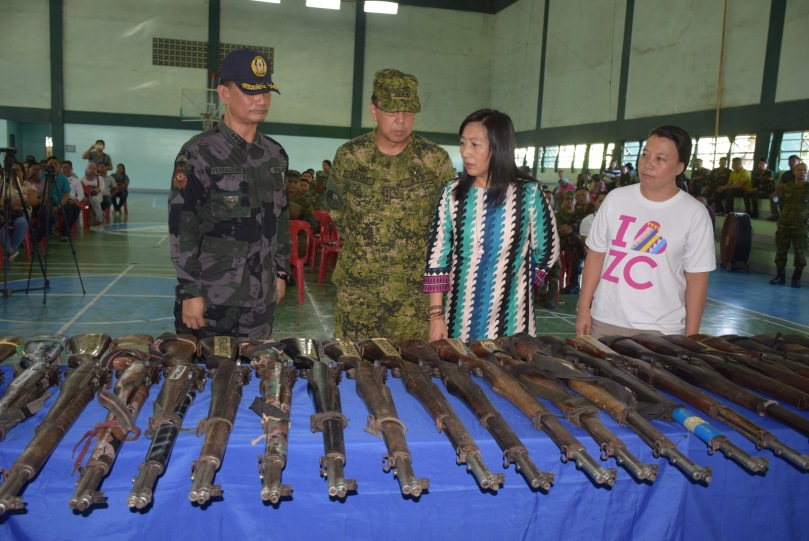
(A lineup of M1 Garands captured by a 2018 joint Philippines police / military operation on Mindanao. Several have been hand-painted in various camouflage patterns.)
WWII weapons in post-WWII troubles
The Philippines after WWII has been something of a contradiction; the capital Manila is an excellent world-class city and the country as a whole is successful and modern. At the same time, the country has endured a seemingly endless string of insurrections after independence, one of which dated to WWII.
the Huks
The Hukbalahap (a Tagalog acronym for “People’s Army Against the Japanese”), was originally a guerilla force that had origins in communist political groups during the Great Depression. Two years before the Japanese attack, some of these groups began making piecemeal trouble against corporate landholders in rural Luzon north of Manila.
When Japanese forces landed, these groups banded together and scavenged guns abandoned by retreating American troops, which they then used against the Japanese.
The effectiveness of the Huks as a guerilla force during WWII is debated and often subjective to what Filipinos recalling the era think of their ideology. By some accounts they are remembered as a fearsome force that wreaked havoc against the occupation in Luzon’s heartland. Others recall a less stellar record, with the Huks not looking at the bigger picture and continuing their violence against farm landlords in the midst of a world war.
Trouble with the Huks started even before WWII had ended. As American forces advanced up Luzon in 1945, guerilla groups were refitted and reorganized by the USA, or simply disarmed. The Huks however refused to do either. As most pre-WWII landlords had fled the countryside in 1941 (many to collaborate with the occupation), now in 1945 the Huk fighters, almost all of whom had been farm serfs in the 1930s, had no desire to welcome them back. Additionally the Huks controlled a decent swath of Luzon by the end of WWII and formed their own parallel civil institutions, which they refused to disband.
Luis Taruc, the Huk leader, was briefly imprisoned by order of Gen. MacArthur in 1945. During the 10-month interim between the end of WWII and the independence of the Philippines, President Truman had no intention of allowing a communist foothold in the Commonwealth’s government, and they were shut out of the political sphere.
The still-armed Huks began their rebellion against the new country literally immediately, with fighting starting only eight weeks after the Philippines became independent in 1946.

(A M8 Greyhound of the Constabulary fighting the Huks in 1946. These WWII vehicles were ideal for the task and used throughout the insurgency.)
The speed with which the Huk rebellion grew was astonishing. In 1946, the Huks were viewed by the USA as an “item of concern” at worst, and generally regarded as one of many loose ends from WWII that would sort itself out eventually. But by 1950, they had essentially hollowed out the main island of Luzon, with the government controlling the coast and large cities, but the interior being run by the Huks, in what was described with increasing concern as “Huklandia” by American intelligence. No longer a sideshow, there was fear that they would overrun the whole country.

(Luis Taruc, the Huk leader, in gym shoes at the center of the photo. Judging by the newspaper headline this was at the start of the Korean War in 1950. The Huks were unique as a communist force armed entirely with WWII American weapons: here, the M1 carbine, M1 Garand rifles, and M1918 BARs.)
The Huks were slowly pushed back by a carrot and stick method. Interviews with captured Huks revealed that most of them had no interest in communism and only wanted land to farm. To that end, some who surrendered voluntarily were presented with small plots of land. At the same time, the USA gave a huge new tranche of WWII-surplus gear to the Philippines in 1950, effectively doubling it’s weapons holdings.

(Additional WWII-surplus P-51 Mustangs were provided to the Philippines to fight the Huks.)
The Huks did not help their own cause with the targeted murder of Aurora Quezon, widow of deceased president Manuel Quezon. This horrified Filipinos across the political spectrum and eroded a lot of support for the Huks. Luis Taruc turned himself in during May 1954 and the insurgency collapsed. By 1955 there were fewer than 1,000 Huk guerillas remaining nationwide and they were viewed as a law enforcement issue rather than a military threat.
the Moros
There are actually two separate groups that fought to have muslim-majority regions of the southern Philippines become independent; the Moro National Liberation Front, which started in 1972, and the more hardline Moro Islamic Liberation Front, which started in 1977. Their weaponry is a mix of everything under the sun; from AK-47s and M16s to RPG-7s and M14s to WWII guns, in particular the M1 Garand.

(Moro rebels with a mix of Cold War and WWII guns, including a M1919 and M1 Garands.)

(After the USA successfully used the AC-47 Spooky in Vietnam, the Philippines also used gunship conversions of the WWII Skytrain. Here, one strafes Moro guerillas in January 1974.)
The Moro National Liberation Front effectively ceased hostilities in the late 1990s and became a political party. The Philippines has been trying to find some peaceful resolution to the Moro Islamic Liberation Front but as of 2018 has been unable to fully end the insurgency.
the New People’s Army
The NPA has the unfortunate distinction of being the world’s longest-running communist insurgency. Formed in 1969, it will pass the half-century mark in February 2019. The NPA is a strict Maoist group that originally sought to emulate the “long march” strategy used by the communists in China after WWII. It is a designated terror group by both the Philippines and the USA.
During the 1970s and 1980s the NPA was remarkably successful in wreaking havoc across the Philippines. It was fairly well-equipped, both with WWII-era and Cold War-era American guns captured or stolen from the government, and Chinese and North Korean guns smuggled into the country.
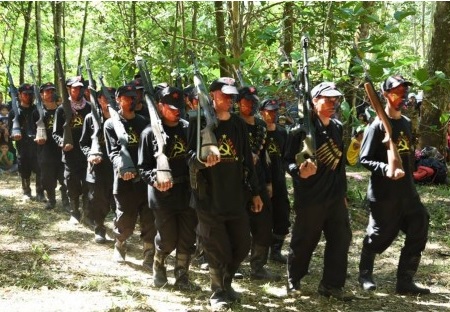
(A NPA detachment in 2014. Some are armed with M1 Garands.)
A Philippines army officer once used the analogy of household mold to the NPA, in that when you think the problem is finally eradicated, it pops up again in a different corner. The description is fair, as the government has been able to keep a lid on the NPA but never end it.
Starting in 2017, President Rodrigo Duterte applied the same thinking used against the Huks in the 1950s to the NPA. Organized units are dealt with harshly on the battlefield, while individual disgruntled members (of which there are many by now) are treated with dignity if they voluntarily surrender.

(A NPA fighter hands over his M1 Garand in 2017 in exchange for a ‘no-questions-asked’ amnesty.) (official Philippines army photo)
There is zero chance of the NPA achieving any of it’s original 1960s goals anymore, and today the guerillas are reduced to attacks on police and army patrols, in addition to kidnappings, arson, and drug trafficking. By November 2018, NPA membership is thought to have dipped below the 5,000 level for the first time in many years.
Abu Sayyaf / ISIS
This is the newest security problem the Philippines faces and by any estimation in 2018, the most dangerous. The original Abu Sayyaf (“father of swords” in Arabic) terror group was formed in 1991 as a hardline jihad organization similar to al-Queda. In July 2014, the group pledged fealty to ISIS.

(A pair of M1 Garands, one with the old Abu Sayyaf logo, and a M14 captured by the Philippines army.)
Abu Sayyaf engaged in typical jihad tactics such as bombings, murders, etc but also branched out into sea piracy. Perhaps the apogee of the group came in 2017, when Abu Sayyaf captured the whole city of Marawi. The Philippines military, aided by airstrikes and armored units, eventually liberated the city in the largest battle on Philippine territory since WWII. By the end of 2018, Abu Sayyaf’s membership was thought to be only 200 full-timers and maybe one or two thousand hangers-on. Despite it’s supposed islamic credentials, the group now specializes in kidnappings-for-profit and narcotics dealing as an affiliate of the “14K” drug triad in Hong Kong.
nonstandard tactics against insurgencies
One idea used off an on over the decades has been gun buy-backs. As the decades went on, this of course ran the risk of rebels turning in WWII guns to fund the purchase of newer weapons.
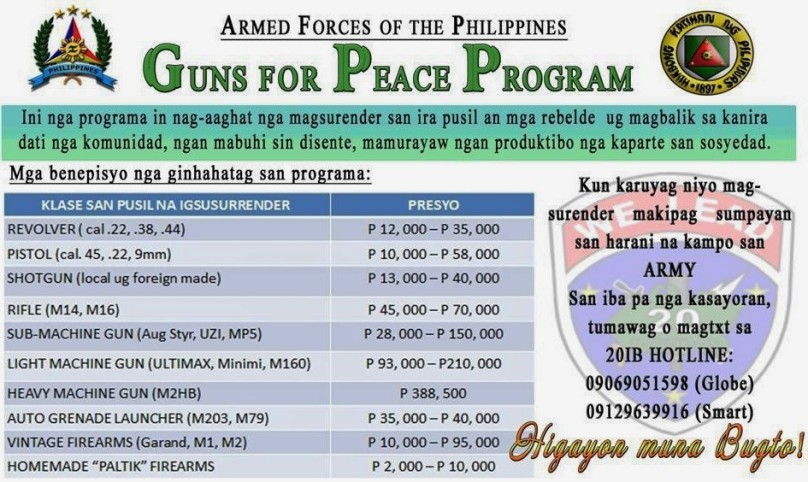
(Buy-back prices in 2017, showing the difference between WWII-era and more modern guns. ₱1 = $0.02 in November 2018.)
Almost all of the rebel groups acquire battlefield weapons via capture from the Philippines army, pilferage from armories, or theft from police. Sometimes a gun is lost to rebels, recaptured, then stolen or pilfered again. In 2007 the Philippines destroyed 45,000 stored guns to limit this.

(The 45,000 gun destruction in 2007. These guns were defective or worn army & police weapons, evidence locker holdings, and guns captured from rebels. Amongst the M16s and M14s are WWII firearms. In the foreground are some M1 Garands and next to the two mortar barrels, a M1919.)
CAFGU
The Citizen Armed Force Geographical Unit (CAFGU) program was started in 1987. CAFGU members are civilian volunteers who are given very basic military training, then paired with an active duty military battalion. They receive a small cash stipend but not regular military wages and benefits. For many years CAGGU patrols were armed exclusively with M1 Garands; more recently they carry a mix of Garands and M14s or M16s.

(CAFGU members with M1 Garands.)
Reformed Ilaga
This vigilante group is not associated with the Philippines government but none the less has proved useful in combating various problems in the country. The original Ilaga group formed in 1971 as a Christian self-defense militia against Moro rebels in the southern Philippines. These ad hoc groups were not directly armed by the then-presidency of Ferdinand Marcos, but on the other hand the government in Manila did nothing to stop them and quietly was happy they existed. At the start they were armed almost entirely with WWII weapons (some which had been sitting in family attics since 1945); these were later complemented with modern guns captured from the Moros or “lost” by sympathetic police or soldiers.
Bagong Ilaga, or Reformed Ilaga in English, started in 2008. It has the same goal of it’s predecessor but now is oriented against both Abu Sayyaf and the Moros, and also narcotics dealers. Also like it’s predecessor; the government does not fund it but generally turns a blind eye towards it.
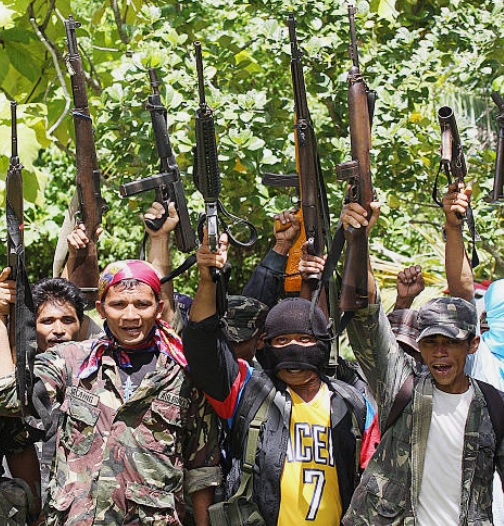
(A Reformed Ilaga unit in 2008. Interspersed with more modern guns are various WWII firearms: a M1 carbine, a M1 Garand, a M1928 Thompson.) (AFP photo)
2018: bringing the Philippines M1 Garands back to the USA
President Duterte has made modernizing the Philippines military a goal, and to that end a new battle rifle plan was formulated. The goal was to retire the M1 Garand around 2020, then the M14 in the following decade; with the M16 to be complemented by a still-TBA new assault rifle. In March 2017 discussions began with the USA about returning the country’s M1 Garands. Under terms of the MAP deal decades ago, the United States retained a first option on the rifles when the recipient country no longer desired them. Of course at the time nobody thought that it would take 55 years for that day to arrive, but none the less the MAP terms were still valid. Legally the Philippines was only bound by these terms on 11,597 Garands (the MAP total) but decided to voluntarily apply them overall. Besides a gesture of goodwill to the USA, there is realistically no appetite on the 21st century world arms market for Garands, and the other option would have been to destroy them in the Philippines at the expense of Filipino taxpayers.
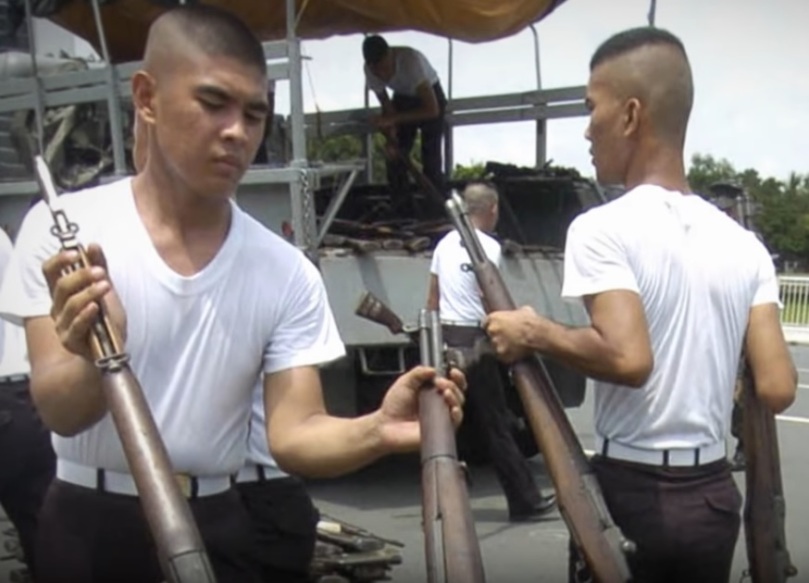
(Philippines servicemen gather M1 Garands in 2017.)

(A stack of retired Garands awaiting the USA’s final decision in 2017.)
The total returned by the Philippines was 86,000 M1 Garands. Formally the return first went through the US Army which obviously no longer had any interest in them. After an inventory by the Defense Logistics Agency, the project was handed off to the Civilian Marksmanship Program, a federally-chartered corporation which offers certain obsolete military weapons for sale to qualified civilians.
When the administration of President Trump gave a final ok to the return in 2018, getting them back to the USA was no small feat. While still in the Philippines, it was found that the packaging did not meet US Customs requirements; and moreover, some of the rifles had termite damage. This required a repackaging of the Garands, after they were fumigated in the Philippines. Together this cost $1 million.
Next, asbestos residue was found on some of the Garands. To meet American environmental laws, an asbestos abatement had to be done costing an additional $1.5 million.
Old legislation required the return to be done aboard an American-flagged merchant ship, which by the 21st century are few and far between. US Customs wanted nothing else mixed into the load, so the whole vessel was chartered to carry only a few shipping containers. This cost $3.2 million. The rifles cleared customs at Long Beach, CA and the containers moved by railroad to the CMP facility in Alabama, costing roughly another $300,000.

(Unpacked Philippines returnee Garands at the CMP’s Anniston, AL facility in mid-2018.) (photo via Garand Collectors Association)
The condition of the Garands, much like each of their individual histories, varied greatly. None were mint or even excellent; the Philippines had gotten full value of these guns in the seven decades since WWII. Some had seen light use and spent years in armories, others had been used in combat in WWII, many had seen combat against the Huks, Moros, and NPA; still others had actually been recovered from rebel groups.

(An interesting example, this M1 Garand has, in addition to a ruptured muzzle and missing sight, a forepiece of the furniture perforated by a hand drill for unknown reasons. This was almost certainly used by a rebel group.) (photo via Garand Collectors Association)

(A first batch of refurbished returnees on a CMP armorer’s rack in March 2018, ready for new owners.)
The 86,000 rifles were refurbished by the CMP in early 2018 and began to be offered for sale to qualified civilians. Depending on the gun’s condition, they cost between $650 to $3,000. Between August to October 2018, all but some “field-” (poor to fair) and “service-” (fair to good) grade returnees had already sold out. Besides the lower-condition refurbished rifles, in late November 2018 the CMP still had some rebuilds using ex-Philippines receivers with aftermarket parts.
(part 2 of a 2-part series)

Thanks very much for both of these posts. I always look forward to reading your research. Thanks.
LikeLiked by 1 person
You didn’t even mention (other than the LST) the warships used by the PN/HD over the years (and still; BRP RAJAH HUMABON was only decommissioned in 2018).
LikeLike
I am thinking about doing something just about the PN’s veteran warships in the future,
LikeLike
As usual very interesting. Keep up the good work!
LikeLiked by 1 person
You didn’t mention the AK47 donated by China within the last 2 or 3 years.
LikeLike
According to MarketsandMarkets Research: Increasing number of soldier modernization programs being carried out by different countries across the globe
Download Information PDF to get crucial insights into Market http://bit.ly/Soldier-System-Market
LikeLike
[…] M1, along with 12,000 others, was loaned to the Philippines in 1963 under the US Military Assistance Program, and received there in 1964. It has an import stamp on the stock. It was returned sometime in the […]
LikeLike
You mentioned Patton tanks above, but I believe we never had any. Those might actually be the M41 Walker Bulldog, of which I think we had 7, but they’re now out of service. They’re all on display, too, as far as I know.
LikeLike
Oh boy! perhaps one of those M1 garand rifle is the one that I used in our ROTC rifle drill compentition in Manila.
LikeLiked by 2 people